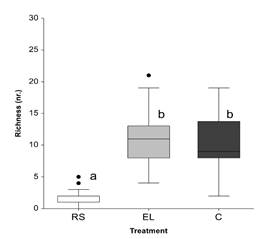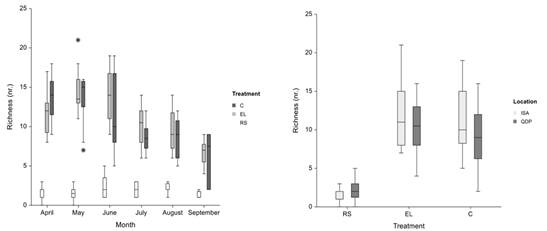INTRODUCTION
The vine (Vitis vinifera L.) is a characteristic crop of Portugal, the Mediterranean Europe, and Europe in general, with significant socioeconomic importance worldwide. According to the European Commission Statistics (2020), Portugal is the tenth-largest wine producer globally and the fifth-largest in Europe, with approximately 0.19 million hectares of Utilized Agricultural Area dedicated to this crop.
In the rows and inter rows of the vineyards, spontaneous vegetation develops, varying in diversity depending on soil management history, edaphoclimatic conditions, and biogeography. In particular, the flora associated with the vine, when negatively affecting the crop through competition or allelopathy, is recognized as weedy flora if the damages, both in quantity and quality of the product, outweigh the costs of control and benefits to ecosystems. In addition to competing for water, space, and nutrients, weeds can also indirectly affect vines by serving as hosts for diseases, specifically caused by viruses and fungi, and pests such as mites and other polyphagous pests. Weed control in vineyards is generally essential in Mediterranean Europe, and various methods exist for doing so. Ideally, the best vineyard soil management allows the presence of spontaneous flora under conditions that harness some of its beneficial aspects while avoiding its unfavorable aspects. The management of vineyard weeds in this region over the last 40 years has primarily involved the application of herbicides (including glyphosate) in the rows, and/or cultivation, and cultivation or cutting of vegetation between the rows. The widespread use of herbicides is due to their lower cost and reduced human labor requirements (Trasande, 2017). While herbicide use may increase productivity, it has proven detrimental to the health and sustainability of agroecosystems. In this context, the National Action Plan for the Sustainable Use of Plant Protection Products (see 2.5.2; República Portuguesa, 2018) encourages good practices and promotes organic farming and integrated production to minimize the harmful effects of these products. There are several alternatives to herbicides for weed control in vineyards, including physical, biological, and cultural methods. In the physical methods group, plowing is expensive and can have negative effects on soil fertility and promote erosion, while thermal weeding involves high equipment costs and significant water consumption, besides being less effective on perennial species (Hammermeister, 2016). In biological methods for controlling vineyard vegetation, animals such as sheep herds have been used, but they generally need to be integrated with other methods (Nóbrega et al., 2017). The use of soil coverings in vineyards has been considered, especially for application between the rows. Vineyard soil cover can be dead or inert (mulching) or through natural or seeded grassing (cover crops): in inert coverings, plastic or biodegradable films, and organic coverings are included; organic dead coverings can be made from materials such as grass straw or crop residues, crushed pruning wood, sawdust, hay, compost, leaves, and bark of trees, among others. Their benefits include protection against temperature variations, reduction of evapotranspiration, improvement of soil physical structure, and microbial health (Polvergiani et al., 2013).
Given the projected scenarios of climate change for the Mediterranean basin, with increased average temperature and reduced and irregular precipitation, more frequent extreme events such as heatwaves, the use of mulches may be a method with the dual objective of reducing the temperature in the vineyard, water losses, and weed control (Fraga & Santos, 2018). The use of eucalyptus (Eucalyptus globulus Labill.) leaves as a material for mulching has attracted researchers' attention due to their high presence of allelopathic chemicals, water-soluble phenolic compounds and oils, making them a possible bioherbicide (Puig et al., 2018). Other materials, such as rice straw (Oryza sativa L.), with low lignin and cellulose content, resistant to degradation by rotting and with less immobilization of nutrients in the soil, have been studied as mulch in several crops, including vineyards. However, in Portugal, there is a lack of studies on the use of rice straw or residues from eucalyptus forestry exploitation as mulches. The main objective of this study is to evaluate the effectiveness of two organic coverings (rice straw and eucalyptus leaves) in controlling weeds in the rows and interrows of vineyards in Portugal.
MATERIALS AND METHODS
The experimental trial was established in March 2022 in two vineyards at the Instituto Superior de Agronomia (ISA) campus in Lisbon and two vineyards at Quinta do Pinto, Merceana-Torres Vedras (QDP), in plots where 'Alvarinho' and 'Syrah' grape varieties are planted, in both locations. Rice straw (RS; 0.25 cm thickness) and eucalyptus leaves (EL; 0.15 cm thickness) were placed in the rows and between the rows of vineyards in 3 plots (corresponding to 3 repetitions) with approximately 4-5 meters x 2.5 meters. The control (C) corresponds to the usual treatment for the entire vineyard. We sampled both mulching materials on the day of the installation and made a chemical analysis to evaluate the ash content (determined by TAPPI standard method T15 os-58), total extracts (Extractives were determined in extraction thimbles by successive extractions with dichloromethane (6 h), ethanol (16 h), and water (16 h) in a Soxhlet apparatus), lignin (Klason and soluble) determined following TAPPI T222 om 98 and TAPPI UM 250 methods respectively and sugars (described by Rowell et al., 2005).
Floristic data (abundance and phenology) were collected in various plots in the first week of each month from April to September 2022. The data (n=216 floristic inventories) were organized in Microsoft Excel software spreadsheets. The sum of species coverage, average coverage, absolute and relative frequency, diversity indices and the Importance Value Index (IVI) were calculated for each replication, globally and by location and/or grape variety ('Alvarinho', 'Syrah') and by treatment. Species with IVI greater than 45 were characterized regarding the possibility of providing a specific ecosystem service. Analysis of variance (ANOVA) and post-hoc tests were performed to analyze if there are significant differences in various calculated parameters between treatments, grape varieties, and locations. A calculation of the costs associated with the studied treatments was also conducted.
RESULTS AND DISCUSSION
During the six-month duration of the trial, 59 taxa belonging to 24 families were inventoried, with Poaceae, Asteraceae, and Geraniaceae being the most represented in terms of number of taxa. Dominant species (more frequent and abundant) were Convolvulus arvensis L., Avena sterilis L., Hordeum murinum L., Picris echioides L., Calendula arvensis L., and Bromus diandrus Roth. The results of ANOVA showed no significant difference in the richness and abundance of species between EL and C, with the RS treatment ensuring reduced richness and species abundance over the six months of observations, different from the other treatments (mean richness <2; mean sum of coverages <55) (Figure 1).


Figure 1 Box-plots of the number of species (left graph) and sum of species superficial cover (right graph) on the rice straw (RS) and Eucalyptus leaves (EL) mulches and Control (C). Different letters show significant differences between treatments (Kruskall-Wallis on ranks and Dunn’s test; p<0,05). Outliers - black circles.
The RS treatment maintained high species dominance in ISA and QDP, successfully controlling most species except for C. arvensis, which occurred but with significantly lower abundance than in C. EL and C showed higher Shannon-Wiener diversity and evenness, but also higher richness and abundance with significant differences between months, with May having the greatest difference between RS and EL/C (Figure 2). There are occasional differences in floristic composition between ISA and QDP and between Syrah and Alvarinho plots, although conclusions about the treatments still consider RS as the treatment with the most success in controlling weed vegetation. However, regarding RS, C. arvensis was the only species with IVI > 45 (for further details consult Losana, 2022).

Figure 2 Box-plots of Richness along the six observations (April to September) for the rice straw (RS), Eucalyptus leaves (EL) mulches and Control (C) (left graph). Box-plots of the Richness for RS, EL and C by each location (ISA and QDP).
Many of the species present in the trial plots contribute to human well-being, providing various ecosystem services in different categories. For example, Convolvulus arvensis has medicinal properties and provides regulation and maintenance services, such as pollination and hosting of beneficial fauna (see e.g. https://pfaf.org/user/; PFAF, 2021). Regarding the costs of treatments, it was evident that mulchings were more expensive than the control. The costs associated with rice straw are higher than eucalyptus leaf mulching, mainly due to the cost of the material and the distance between the material availability and the studied vineyards, but the post-trial longevity of mulches was not assessed. The chemical analysis (in Losana, 2022) revealed a higher sugar concentration in RS (45.9%) when compared to EL (28.5 %), and especially in glucose and xylose. The ash content varied considerably between mulching materials, with 5.2% and 10.5%, respectively for RS and EL. The total content of extractives was higher in EL (43.8%) than in RS (23.7%), as expected. The chemical analysis demonstrates that both mulches have potential to control weeds, however, the content of phenolic compounds and their effects on local weeds deserve further investigation.
CONCLUSIONS
Rice straw mulch was the most effective treatment to control weeds. However, eucalyptus leaves mulch was considered the most sustainable option for ecosystems and more economically viable, but likely required a greater material thickness to improve the control of some weeds, such as C. arvensis, Hordeum murinum, and Avena sterilis. It also probably requires more maintenance in subsequent years than the rice straw mulch. There are important research gaps in relation to the effects of the composition of mulches on the vines, their productivity and grape quality, as well as on the fauna auxiliary communities, soil microbiota and mineral composition. Following this work, it would be interesting to study other benefits of mulching, such as the effect on reducing soil temperature and water losses, as well as improving soil conditions in terms of microbial life and fertility. Finally, studies of new products such as fiber-based screens and eucalyptus essential oil combined with straw could result in intermediate solutions with good potential for weed control and climate regulation.














